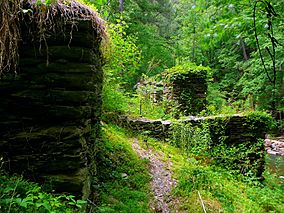Akers Mill facts for kids
Quick facts for kids Akers Mill |
|
|---|---|

Ruined foundation flagstones of Akers Mill
|
|
| Location | Cobb County, Georgia, United States |
| Nearest city | Smyrna, Georgia |
| Elevation | 813 ft (248 m) |
Akers Mill was a group of at least two mills built in the 1800s. They were located next to Rottenwood Creek in Cobb County, Georgia, United States. One of the main buildings was a gristmill, which is a mill that grinds grain. This gristmill was built right into the creek bank. It had six levels, or terraces, with each level working as a different floor for the mill's operations.
The mills started operating just before the American Civil War. In 1873, the Akers family bought them. They used the mills to make flour and meal for their grocery stores in the Atlanta area. The Akers brothers even built new roads to the mill. They also farmed the land nearby. About 60 people worked at the mills. The Akers family also built homes for these workers in a small village south of the mills.
Contents
How Akers Mill Made Products
The gristmill was built right on the creek. This was smart because it could use the natural power of the water. Rottenwood Creek had a strong flow back then. It moved about 720 cubic feet of water every minute!
In 1880, a newspaper called the Marietta Journal shared exciting news. Akers Mill had a new way of milling grain. This new process helped them get more flour from each bushel of wheat. They could get 43 pounds of flour from a bushel, up from 39 pounds. Plus, the flour was even finer and better quality.
Daily Production at the Mill
The flour mill at Akers Mill could make 200 barrels of flour every day. Each barrel weighed 196 pounds. The corn mill was even busier. It could produce 1,500 bushels of cornmeal in the same amount of time.
A large 36-inch turbine powered the flour mill. A turbine is like a big wheel that spins when water flows through it. If there wasn't enough water, an 80-horsepower engine helped out. Records from the 1880 U.S. Census show how powerful the water flow was. The first mill's turbine used water falling from 23 feet high. The second mill's turbine used water falling from 26 feet high.
Akers Mill Today
Akers Mill faced money problems and went bankrupt in 1879. The mill finally closed in 1889. It had debts of $100,000, which was a lot of money back then.
As the Atlanta area grew, the old gristmill was forgotten. Its buildings slowly fell apart. But on August 15, 1978, the U.S. National Park Service decided to protect what was left of the mill. It became part of the Chattahoochee River National Recreation Area.
Discovering the Mill's Past
In the early 1990s, experts studied the area. This was part of a project to build the Kennedy Parkway. They found the mill's original levels, or terraces, still mostly in place. They also found old items buried in the ground. This allowed them to learn a lot about how the mill worked. It's rare for archaeologists to find such detailed information about old mill technology. Usually, the machines were taken out before buildings were torn down.
Some parts of the site could not be saved. So, a small amount of digging was done there. It seemed that this area was more for homes than for making products.
Today, you can still see the old terraces and flagstone foundations. These are the stone bases of the buildings. They stand near the Rottenwood Creek Multi-Use Trail, right by the waterway.
The modern area of Cumberland has grown up nearby. Akers Mill Road is named after the old mill. This road now crosses Cumberland Boulevard on a hill to the northwest.
The old ruins of Akers Mill are located at these GPS coordinates: N33°53.189' W084°27.202'.


